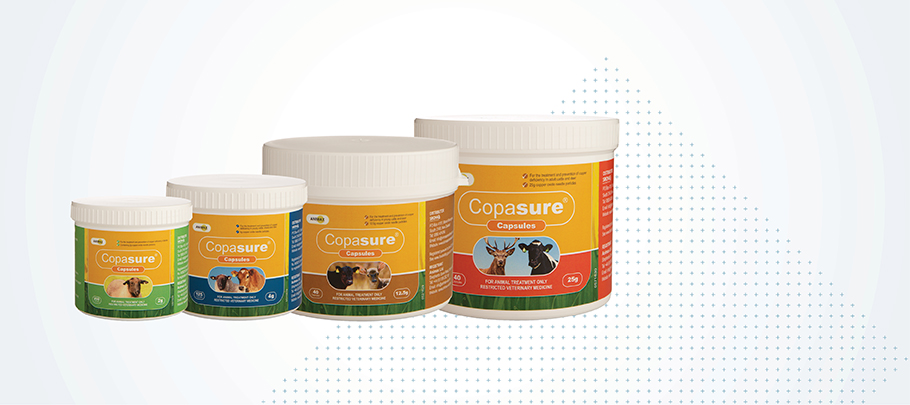
Copasure
Copasure is an intra ruminal capsule for cattle, sheep or deer providing slow release supplementation of copper in the form of copper oxide needles for up to 6 months. Copasure is available in; 25g, 12.5g, 4g and 2g bolus.
Long lasting copper as copper oxide needles for ruminants
Copasure® provides copper for ruminants in the form of copper oxide needles. The gelatin capsules are administered orally and immediately dissolve in the rumen to release hundreds of copper oxide particles. For copper to be released in a bioavailable form the needles must become trapped in abomasal folds and dissolve in the acidic environment of the abomasum.
The rate of dissolution is highly dependent on abomasal pH with the rate of dissolution reducing as pH rises. Heavy infestation of the abomasum by parasites has been shown to reduce acid secretion, resulting in raised abomasal pH and a subsequent reduction in copper release from copper oxide wire particles.
Conversely the presence of copper oxide wire needles in the abomasum has been shown to have an anthelmintic effect on Haemonchus contortus, reducing the numbers of (abomasal) parasites present in treated animals.
Advantages:
- Effective in both primary and secondary copper deficiency
- Independently proven to be an effective way of supplementing copper, even in the
presence of dietary antagonists, incl. molybdenum - Easy to use – no injections, no abscesses and no pain or stress to the animal
- Single application lasts approx. 6 months; up to 6 times longer than copper injections
- Optimum, known amount of copper delivered to each animal and controlled, unlike other
methods where greedy animals may take too much and others not enough - Good copper reserves in the cow at calving ensure a good level of copper in the calf
- Available in four strengths
- 2g and 4g for lambs and sheep.
- 12.5g for deer and young cattle over 100kg
- 25g for deer and cattle over 240 kg
Low copper and or high antagonists in the soil or diet like molybdenum can lead to:
- Reduced fertility
- Reduced growth rates in young animals
- Reduced resistance to disease
- Reduced milk production
- Faded coat and spectacle eye
- Depressed bull libido
- Joint disorders
- Reduced semen quality
- Diarrhea
- Bone deformities
- Spontaneous fractures
Background:
Copper is probably the most economically important of the trace element deficiencies, particularly in cattle. The bioavailability of copper to ruminant animals is greatly influenced by the molybdenum, sulphur and iron content of the diet which can be particularly high with the intake of soil when grazing crops such as kale.

